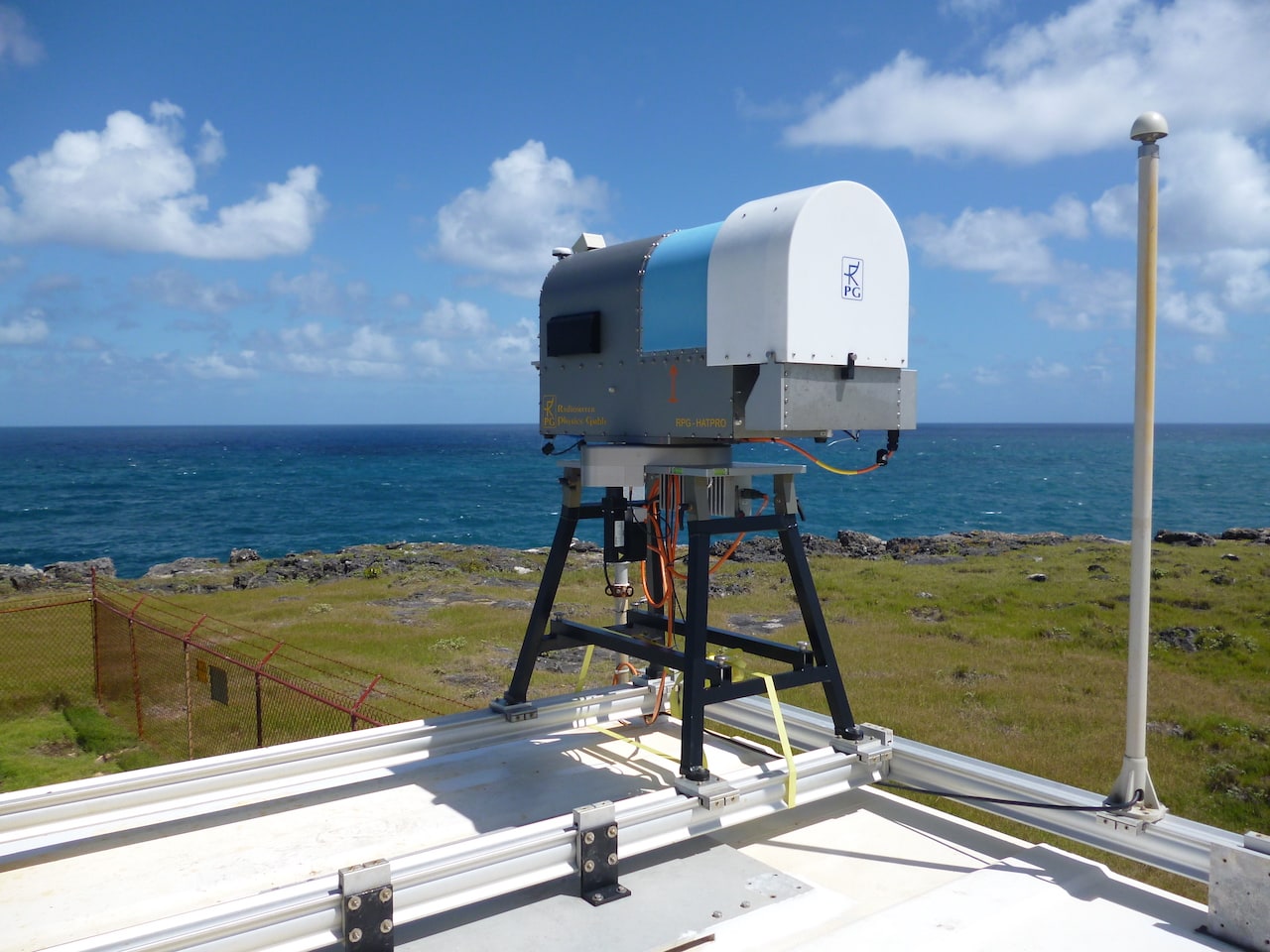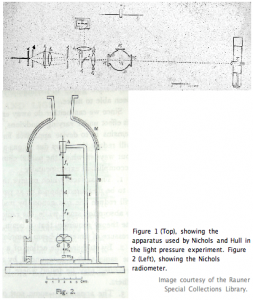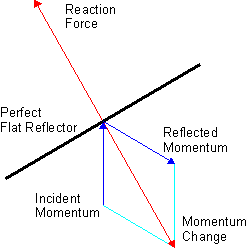|
Radiometer
A radiometer or roentgenometer is a device for measuring the radiant flux (power) of electromagnetic radiation. Generally, a radiometer is an infrared radiation detector or an ultraviolet detector. Microwave radiometers operate in the microwave wavelengths. While the term ''radiometer'' can refer to any device that measures electromagnetic radiation (e.g. light), the term is often used to refer specifically to a Crookes radiometer ("light-mill"), a device invented in 1873 in which a rotor (having vanes which are dark on one side, and light on the other) in a partial vacuum spins when exposed to light. A common belief (one originally held even by Crookes) is that the momentum of the absorbed light on the black faces makes the radiometer operate. If this were true, however, the radiometer would spin away from the non-black faces, since the photons bouncing off those faces impart more momentum than the photons absorbed on the black faces. Photons do exert radiation pressure on ... [...More Info...] [...Related Items...] OR: [Wikipedia] [Google] [Baidu] |
Microwave Radiometer
A microwave radiometer (MWR) is a radiometer that measures energy emitted at one millimeter-to-metre wavelengths (frequencies of 0.3–300 GHz) known as microwaves. Microwave radiometers are very sensitive receivers designed to measure thermally-emitted electromagnetic radiation. They are usually equipped with multiple receiving channels to derive the characteristic emission spectrum of planetary atmospheres, surfaces or extraterrestrial objects. Microwave radiometers are utilized in a variety of environmental and engineering applications, including remote sensing, weather forecasting, climate monitoring, radio astronomy and radio propagation studies. Using the microwave spectral range between 1 and 300 GHz provides complementary information to the visible and infrared spectral range. Most importantly, the atmosphere and also vegetation is semi-transparent in the microwave spectral range. This means its components like dry gases, water vapor, or hydrometeors interact with mic ... [...More Info...] [...Related Items...] OR: [Wikipedia] [Google] [Baidu] |
Crookes Radiometer
The Crookes radiometer (also known as a light mill) consists of an airtight glass bulb containing a partial vacuum, with a set of vanes which are mounted on a spindle inside. The vanes rotate when exposed to light, with faster rotation for more intense light, providing a quantitative measurement of electromagnetic radiation intensity. The reason for the rotation was a cause of much scientific debate in the ten years following the invention of the device, but in 1879 the currently accepted explanation for the rotation was published. Today the device is mainly used in physics education as a demonstration of a heat engine run by light energy. It was invented in 1873 by the chemist Sir William Crookes as the by-product of some chemical research. In the course of very accurate quantitative chemical work, he was weighing samples in a partially evacuated chamber to reduce the effect of air currents, and noticed the weighings were disturbed when sunlight shone on the balance. Investigat ... [...More Info...] [...Related Items...] OR: [Wikipedia] [Google] [Baidu] |
Spectroradiometer
A spectroradiometer is a light measurement tool that is able to measure both the wavelength and amplitude of the light emitted from a light source. Spectrometers discriminate the wavelength based on the position the light hits at the detector array allowing the full spectrum to be obtained with a single acquisition. Most spectrometers have a base measurement of counts which is the un-calibrated reading and is thus impacted by the sensitivity of the detector to each wavelength. By applying a calibration, the spectrometer is then able to provide measurements of spectral irradiance, spectral radiance and/or spectral flux. This data is also then used with built in or PC software and numerous algorithms to provide readings or Irradiance (W/cm2), Illuminance (lux or fc), Radiance (W/sr), Luminance (cd), Flux (Lumens or Watts), Chromaticity, Color Temperature, Peak and Dominant Wavelength. Some more complex spectrometer software packages also allow calculation of PAR μmol/m2/s, Metamerism ... [...More Info...] [...Related Items...] OR: [Wikipedia] [Google] [Baidu] |
Net Radiometer
A net radiometer is a type of actinometer used to measure net radiation (NR) at the Earth's surface for meteorological applications. The name net radiometer reflects the fact that it measures the difference between downward/incoming and upward/outgoing radiation from Earth. It is most commonly used in the field of ecophysiology. See also * radiometer *pyranometer * pyrgeometer *irradiance In radiometry, irradiance is the radiant flux ''received'' by a ''surface'' per unit area. The SI unit of irradiance is the watt per square metre (W⋅m−2). The CGS unit erg per square centimetre per second (erg⋅cm−2⋅s−1) is often used ...Meteo-Technology instrumentation website References External links * Specifications, drawings and pictures courtesy of Hukseflux Thermal Sensorswww.Hukseflux.com* Specifications courtesy of Delta OHwww.deltaohm.comwww.kippzonen.com {{Meteorological equipment Electromagnetic radiation meters Radiometry es:Radiómetro Neto pl:Pyranometr ... [...More Info...] [...Related Items...] OR: [Wikipedia] [Google] [Baidu] |
Nichols Radiometer
A Nichols radiometer was the apparatus used by Ernest Fox Nichols and Gordon Ferrie Hull in 1901 for the measurement of radiation pressure. It consisted of a pair of small silvered glass mirrors suspended in the manner of a torsion balance by a fine quartz fibre within an enclosure in which the air pressure could be regulated. The torsion head to which the fiber was attached could be turned from the outside using a magnet. A beam of light was directed first on one mirror and then on the other, and the opposite deflections observed with mirror and scale. By turning the mirror system around to receive the light on the unsilvered side, the influence of the air in the enclosure could be ascertained. This influence was found to be of almost negligible value at an air pressure of about 16 mmHg (2.1 kPa). The radiant energy of the incident beam was deduced from its heating effect upon a small blackened silver disk, which was found to be more reliable than the bolometer when it w ... [...More Info...] [...Related Items...] OR: [Wikipedia] [Google] [Baidu] |
Pyranometer
A pyranometer is a type of actinometer used for measuring solar irradiance on a planar surface and it is designed to measure the solar radiation flux density (W/m2) from the hemisphere above within a wavelength range 0.3 μm to 3 μm. The name pyranometer stems from the Greek words ''πῦρ'' (''pyr''), meaning "fire", and ''ἄνω'' (''ano''), meaning "above, sky". A typical pyranometer does not require any power to operate. However, recent technical development includes use of electronics in pyranometers, which do require (low) external power. Explanation The solar radiation spectrum that reaches earth's surface extends its wavelength approximately from 300 nm to 2800 nm. Depending on the type of pyranometer used, irradiance measurements with different degrees of spectral sensitivity will be obtained. To make a measurement of irradiance, it is required by definition that the response to "beam" radiation varies with the cosine of the angle of incidence. This ensur ... [...More Info...] [...Related Items...] OR: [Wikipedia] [Google] [Baidu] |
Infrared Radiation
Infrared (IR), sometimes called infrared light, is electromagnetic radiation (EMR) with wavelengths longer than those of visible light. It is therefore invisible to the human eye. IR is generally understood to encompass wavelengths from around 1 millimeter (300 GHz) to the nominal red edge of the visible spectrum, around 700 nanometers (430 THz). Longer IR wavelengths (30 μm-100 μm) are sometimes included as part of the terahertz radiation range. Almost all black-body radiation from objects near room temperature is at infrared wavelengths. As a form of electromagnetic radiation, IR propagates energy and momentum, exerts radiation pressure, and has properties corresponding to both those of a wave and of a particle, the photon. It was long known that fires emit invisible heat; in 1681 the pioneering experimenter Edme Mariotte showed that glass, though transparent to sunlight, obstructed radiant heat. In 1800 the astronomer Sir William Herschel discovered ... [...More Info...] [...Related Items...] OR: [Wikipedia] [Google] [Baidu] |
Radiometry
Radiometry is a set of techniques for measuring electromagnetic radiation, including visible light. Radiometric techniques in optics characterize the distribution of the radiation's power in space, as opposed to photometric techniques, which characterize the light's interaction with the human eye. The fundamental difference between radiometry and photometry is that radiometry gives the entire optical radiation spectrum, while photometry is limited to the visible spectrum. Radiometry is distinct from quantum techniques such as photon counting. The use of radiometers to determine the temperature of objects and gasses by measuring radiation flux is called pyrometry. Handheld pyrometer devices are often marketed as infrared thermometers. Radiometry is important in astronomy, especially radio astronomy, and plays a significant role in Earth remote sensing. The measurement techniques categorized as ''radiometry'' in optics are called ''photometry'' in some astronomical applicat ... [...More Info...] [...Related Items...] OR: [Wikipedia] [Google] [Baidu] |
Radiation Pressure
Radiation pressure is the mechanical pressure exerted upon any surface due to the exchange of momentum between the object and the electromagnetic field. This includes the momentum of light or electromagnetic radiation of any wavelength that is absorbed, reflected, or otherwise emitted (e.g. black-body radiation) by matter on any scale (from macroscopic objects to dust particles to gas molecules). The associated force is called the radiation pressure force, or sometimes just the force of light. The forces generated by radiation pressure are generally too small to be noticed under everyday circumstances; however, they are important in some physical processes and technologies. This particularly includes objects in outer space, where it is usually the main force acting on objects besides gravity, and where the net effect of a tiny force may have a large cumulative effect over long periods of time. For example, had the effects of the Sun's radiation pressure on the spacecraft of the V ... [...More Info...] [...Related Items...] OR: [Wikipedia] [Google] [Baidu] |
Ultraviolet
Ultraviolet (UV) is a form of electromagnetic radiation with wavelength from 10 nm (with a corresponding frequency around 30 PHz) to 400 nm (750 THz), shorter than that of visible light, but longer than X-rays. UV radiation is present in sunlight, and constitutes about 10% of the total electromagnetic radiation output from the Sun. It is also produced by electric arcs and specialized lights, such as mercury-vapor lamps, tanning lamps, and black lights. Although long-wavelength ultraviolet is not considered an ionizing radiation because its photons lack the energy to ionize atoms, it can cause chemical reactions and causes many substances to glow or fluoresce. Consequently, the chemical and biological effects of UV are greater than simple heating effects, and many practical applications of UV radiation derive from its interactions with organic molecules. Short-wave ultraviolet light damages DNA and sterilizes surfaces with which it comes into contac ... [...More Info...] [...Related Items...] OR: [Wikipedia] [Google] [Baidu] |
Microwave
Microwave is a form of electromagnetic radiation with wavelengths ranging from about one meter to one millimeter corresponding to frequency, frequencies between 300 MHz and 300 GHz respectively. Different sources define different frequency ranges as microwaves; the above broad definition includes both Ultra high frequency, UHF and Extremely high frequency, EHF (millimeter wave) bands. A more common definition in radio-frequency engineering is the range between 1 and 100 GHz (wavelengths between 0.3 m and 3 mm). In all cases, microwaves include the entire Super high frequency, SHF band (3 to 30 GHz, or 10 to 1 cm) at minimum. Frequencies in the microwave range are often referred to by their Radio band#IEEE, IEEE radar band designations: S band, S, C band (IEEE), C, X band, X, Ku band, Ku, K band (IEEE), K, or Ka band, Ka band, or by similar NATO or EU designations. The prefix ' in ''microwave'' is not meant to suggest a wavelength in the M ... [...More Info...] [...Related Items...] OR: [Wikipedia] [Google] [Baidu] |








